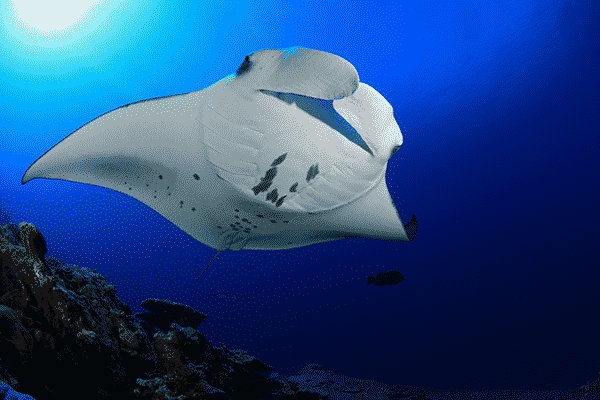Here’s a good article by Patrick Sather for A-Z Animals on the difference between manta rays and stingrays. Our manta ray snorkel tours offers a wonderful experience to get up close and personal with these graceful creatures.
The 9 Key Differences Between Manta Rays and Stingrays
Manta Ray vs Stingray: Taxonomy
Manta rays and stingrays belong to the order Myliobatiformes, one of the four groups belonging to the superorder Batoidea. While they contain similar attributes, including flattened, boneless bodies and enlarged pectoral fins, the two belong to different families. Manta rays belong to the family Mobulidae. For years, many scientists considered Mobulidae a subfamily of Myliobatidae or the eagle ray family. However, most scientists now identify it as a distinct family separate from the eagle rays. Meanwhile, stingrays belong to eight respective families. They include Hexatrygonidae (sixgill stingrays), Plesiobatidae (deepwater stingrays), Urolophidae (stingarees), Urotrygonidae (round rays), Dasyatidae (whiptail stingrays), Potamotrygonidae (river stingrays), Gymnuridae (butterfly rays), and the previously mentioned Myliobatidae.
Manta Ray vs Stingray: Size
Depending on the species of stingray, manta rays and stingrays can vary wildly in terms of size. The giant oceanic ray is the largest ray in the world and can reach lengths up to 23 feet wide and weigh nearly 2,980 pounds. Right behind these giants ranks the reef manta ray, which can reach up to 18 feet wide. On the other hand, stingrays range from the size of a dinner plate to massive specimens only slightly smaller than a manta ray. For example, the Atlantic stingray typically only measures 10 inches wide and weighs a mere five pounds. Yet, the short-tail stingray can reach up to 6.9 feet wide and weigh over 770 pounds. Similarly, giant freshwater stingrays can grow up to 8 feet wide and weigh up to 800 pounds.
Manta Ray vs Stingray: Distribution
Manta rays typically either live in the open ocean or along reefs near the coastline. They range as far north as North Carolina and as far south as northern New Zealand. Overall, they prefer warm temperate, subtropical, and tropical waters. Meanwhile, stingrays enjoy a much wider distribution and live in more varied habitats. They live in the open ocean, along the seafloor, near reefs, and also in freshwater rivers. That said, they still mainly congregate in warmer subtropical and tropical waters.
Manta Ray vs Stingray: Tail
Aside from their size, one of the most significant differences separating a manta ray vs stingray is their tails. The tail on a manta ray does not contain a barb, which effectively makes them harmless to humans. Meanwhile, most stingray species possess one to serrated venomous spines at the base of their tail. They rarely use their spines as weapons but will lash out with their whip-like tail when threatened. Although the venom in stingray spines rarely proves fatal to humans, the barbs themselves can deliver a nasty and painful sting. Generally, soaking the affected area in hot water will relieve the pain and kill any lingering stingray venom.
Manta Ray vs Stingray: Diet and Feeding Behavior
Of the many species of ray, only manta and devil rays evolved into filter feeders. This explains why, unlike most rays, the mouth of a manta ray is located at the front of its body rather than underneath its head. As they swim near the ocean’s surface, their mouths filter zooplankton from the water, including shrimp, krill, and planktonic crabs. In addition, manta rays exhibit advanced hunting behaviors. At deeper depths, a ray will group small fish into tight balls before dashing through and sucking up the fish with a wide-open mouth. On the opposite end of the spectrum, most stingrays operate as bottom feeders. Many species swim near the bottom of oceans or rivers, guiding prey into their mouths. They possess specialized jaws that allow them to crush the shells of mollusks, and their diet consists primarily of clams, worms, oysters, mussels, and shrimp. However, some benthic or deep-sea stingrays adapted as ambush hunters. These stingrays bury their bodies in the sand and dart out to consume small fish or squid that swim too close.
Manta Ray vs Stingray: Lifespan
Another key difference that distinguishes a manta ray vs stingray concerns their lifespan. In the wild, manta rays frequently live up to 40 years old. Furthermore, some scientists estimate that the oldest manta rays reach 50 years of age. Meanwhile, most stingrays only live between 15 to 25 years. While the lifespan of a stingray is by no means short, it measures only half that of a manta ray.
Manta Ray vs Stingray: Intelligence
Manta rays and stingrays have both garnered a reputation for their high levels of intelligence. In particular, manta rays rank among the most intelligent animals on the planet. They possess the largest brains as well as the largest brain-to-body ratio of any fish. Manta rays can pass the mirror test, which is a basic test to determine an animal’s ability of self-recognition. Only a few other species can attest to the same, including bottlenose dolphins, elephants, and some apes. Stingrays, on the other hand, exhibit more low-key intelligence. They can manipulate objects to get food and will engage in playful behavior just for their amusement.
Manta Ray vs Stingray: Temperament
Despite their enormous size, manta rays are gentle giants. Due to their eating behavior and lack of stinger, they possess little threat to humans. On the contrary, they tend to act curious around people and eagerly investigate objects that pique their interest. In addition, they partake in fastidious cleaning rituals by allowing smaller fish to remove parasites from their bodies. Meanwhile, the temperament of most stingrays is more muddled and harder to pin down. Typically, stingrays pose little threat to humans. Thanks to their high intelligence and shy nature, they tend to avoid contact but tolerate touching when necessary in environments such as aquariums. While they can act playfully at times, they can also turn aggressive when cornered. This is how the famous wildlife expert, Steve Irwin, died when he got too close to a short-tail stingray. The stingray pierced his thoracic while with its barbed tail, killing him almost instantly.
Manta Ray vs Stingray: Mating Rituals
Manta rays and stingrays each partake in unique mating rituals that differ drastically from one another. When manta rays mate, a female will attract a group of potential males. She will then put the males through a series of acrobatic twists and turns. The males follow the female as she weaves this intricate dance, with the female picking her favorite prospect from the available suitors. Compared to manta rays, the mating ritual of stingrays is much less romantic. During courtship, a male stingray will bite a female on the back or her fins. While females appear to struggle during courtship, they cease struggling once they consent to the male’s advances.















